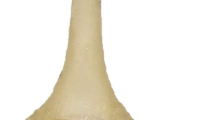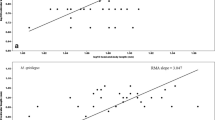Abstract
We report body mass and testicular size in 258 anubis (Papio anubis or P. hamadryas anubis) and 59 hamadryas (P. hamadryas or P. h. hamadryas) baboons, live-trapped in Ethiopia. As predicted by theories of sexual selection by sperm competition, among hamadryas baboons, which are monandrous, fully adult males have absolutely and relatively smaller testes than those of comparable males among anubis baboons, which are polyandrous. Male hamadryas are also ca. 10% smaller in bodily mass as adults. The intertaxonal difference in adults is due entirely to the fact that in male anubis baboons, testicular and bodily mass continue to grow up to full adulthood–the age at which most males emigrate from their natal troop and initiate a confrontational breeding strategy among unrelated animals. By contrast, male hamadryas baboons, which are usually philopatric, attain adult body mass and testicular size as subadults. In both species, juveniles experience rapid testicular growth peaking in rate at ca. 12kg body mass, but testicular descent and growth starts earlier in hamadryas than in anubis baboons. Juvenile hamadryas baboons have relatively larger testes than their anubis equivalents, perhaps because male philopatry allows the mating strategy of male hamadryas baboons to be initiated during juvenile life and therefore permits some sperm competition between juveniles and adults.
Similar content being viewed by others
References
Abegglen, J.-J. (1984). On Socialization in Hamadryas Baboons, Assoc. Univ. Presses, Cranbury, NJ.
Alberts, S. C., and Altmann, J. (1995). Preparation and activation: Determinants of age at reproductive maturity in male baboons Behav. Ecol. Sociobiol. 36: 397-406.
Brett, F. L., Turner, T. R., Jolly, C. J., and Cauble, R. G. (1982). Trapping baboons and vervet monkeys from wild, free-ranging populations. J. Wildlife Mgmt. 46: 164-174.
Clutton-Brock, T. H. and Harvey, P. H. (1984). Comparative approaches to investigating adaptation. In Krebs, J. R., and Davies, N. B. (Eds.), Behavioral Ecology: An Evolutionary Approach, 2nd edn., Blackwell, England, pp. 7-29.
Crawford, B. A., Harewood, W. J., and Handelsman, D. J. (1997). Growth and hormone characteristics of pubertal development in the hamadryas baboon. J. Med. Primatol. 26: 153-163.
Eisenberg, J. F., Muckenhirn, N. A., and Rudran, R. (1972). The relation between ecology and social structure in primates. Science 176: 1-12.
Glander, K. E., Wright P. C., Daniels, P. S., and Merenlender A. M. (1992). Morphometrics and testicle size of rain forest lemur species from southeastern Madagascar. J. Hum. Evol. 22: 1-18.
Harcourt, A. H. (1997). Sperm competition in primates. Am. Naturalist 149: 189-194.
Harcourt, A. H., Harvey P. H., Larson S. G., and Short R. V. (1981). Testis weight, body weight, and breeding system in primates. Nature 293: 55-57.
Harvey, P. H., and Harcourt, A. H. (1984). Sperm competition, testes size and breeding systems in primates. In Smith, R. L. (ed.), Sperm Competition and the Evolution of Animal Mating Systems, Academic Press, Orlando, FL, pp. 589-600.
Jacobs, M. J., and Schloeder, C. A. (1993). The Awash National Park Management Plan, NYZS-The Wildlife Conservation Society International and Ethiopian Wildlife Conservation Organization, Addis Ababa, Ethiopia, pp. 1-285.
Jolly, C. J. (1963). A Suggested case of evolution by sexual selection in primates. Man 222: 177-178.
Jolly, C. J. (1993). Species, subspecies, and baboon systematics. In Kimbel, W. H., and Martin, L. B. (Eds.), Species, Species Concepts, and Primate Evolution, Plenum, New York.
Kaplan, J. R., Phillips-Conroy, J. E., Fontenot, M. B., Jolly, C. J., Fairbanks, L. A., and Mann, J. J. (1999). Cerebrospinal fluid monoaminergic metabolites differ in wild anubis and hybrid (anubis-hamadryas) baboons: Possible relationships to life history and behavior. Neuropsychopharmacology 20: 517-524.
Kummer, H. (1968). Social Organization of Hamadryas Baboons, Aldine, Chicago.
Kummer, H. (1995). In Quest of the Sacred Baboon, Princeton University Press, Princeton, NJ.
Moller, A. P. (1988). Ejaculate quality, testes size and sperm competition in primates. J. hum. Evol. 17: 479-488.
Nagel, U. (1973). A comparison of anubis baboons, hamadryas baboons and their hybrids at a species border in Ethiopia. Folia Primatol. 19: 104-165.
Nystrom, P. (1992). Mating Success of Hamadryas, Anubis and Hybrid Male Baboons in a Mixed Social Group in the Awash National Park, Ethiopia, PhD Dissertation, Washington University, St Louis.
Packer, C. (1979). Inter-troop transfer and inbreeding avoidance in Papio anubis. Anim. Behav. 27: 1-34.
Parker, G. A. (1990a). Sperm competition games: Raffles and roles. Proc. Roy. Soc. Lond. Ser. B 242: 120-126.
Parker, G. A. (1990b). Sperm competition games: Guards and extra pair copulations. Proc. Roy. Soc. Lond. Ser. B 242: 127-133.
Phillips-Conroy, J. E., and Jolly, C. J. (1986). Changes in the structure of the baboon hybrid zone in the Awash National Park, Ethiopia. Am. J. Phys. Anthropol. 71: 337-349.
Phillips-Conroy, J. E., and Jolly, C. J. (1988). Dental eruption schedules of wild and captive baboons. Am. J. Primatol. 15: 17-29.
Phillips-Conroy, J. E., Jolly, C. J., and Brett, F. L. (1991). Characteristics of hamadryas-like male baboons living in anubis baboon troops in the Awash Hybrid Zone, Ethiopia. Am. J. Phys. Anthropol. 86: 353-368.
Phillips-Conroy, J. E., Jolly, C. J., Nystrom, P. D., and Hemmalin, H. A. (1992). Migration of male hamadryas baboons into anubis groups in the Awash National Park. In Smith, E. O., and Sprague, D. (Eds.), Dispersal and Migration in Nonhuman Primates. Int. J. Primat. 13: 455-476.
Popp, J. L., and DeVore, I. (1979). Aggressive competition and social dominance theory. In Hamburg, D. A., and McCown, E. R. (Eds.), Perspectives on Human Evolution, Vol. 5: Behavior of Great Apes, Menlo Park, CA.
Sapolsky, R. M. (1991). Testicular function, social rank and personality among wild baboons. Psychoneuroendocrinology 16: 281-293.
Short, R. V. (1979). Sexual selection and its component parts, somatic and genital selection, as illustrated by man and the great apes. Adv. Stud. Behav. 9: 131-158.
Sigg, H., Stolba, A., Abegglen, J. J., and Dasser, V. (1982). Life history of hamadryas baboons: Physical development, infant mortality, reproductive parameters and family relationships. Primates 23: 473-487.
Smuts, B. B. (1985). Sex and Friendship in Baboons, Aldine, New York.
Stockley P., and Purvis A. (1993). Sperm competition in mammals: A comparative study of male roles and relative investment in sperm production. Funct. Ecol. 7: 560-570.
Strum, S. C. (1994). Reconciling aggression and social manipulation as a means of competition. I: Life-history perspective. Int. J. Primatol. 15: 739-765.
Swedell, L (2000). Social Behavior and Reproductive Strategies of Female Hamadryas Baboons, Papio Hamadryas Hamadryas, in Ethiopia, PhD Dissertation, Columbia University.
Williams-Blangero, S., Vanderberg, J. L., Blangero, J., Konigsberg, L., and Dyke, B. (1990). Genetic differentiation between baboon subspecies: Relevance for biomedical research. Am. J. Primatol. 20: 67-81.
Zinner, D., Schwibbe, M. H., and Kaumanns, W. (1994). Cycle synchrony and probability of conception in female hamadryas baboons, Papio hamadryas. Behav. Ecol. Sociobiol. 35: 175-183.
Author information
Authors and Affiliations
Rights and permissions
About this article
Cite this article
Jolly, C.J., Phillips-Conroy, J.E. Testicular Size, Mating System, and Maturation Schedules in Wild Anubis and Hamadryas Baboons. International Journal of Primatology 24, 125–142 (2003). https://doi.org/10.1023/A:1021402730111
Issue Date:
DOI: https://doi.org/10.1023/A:1021402730111




